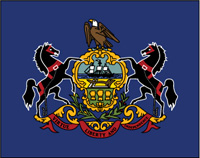
THANK YOU!
YOUR PURCHASE OF THESE BOOKS SUPPORTS THE WEB SITES THAT BRING TO YOU THE HISTORY BEHIND OLD AIRFIELD REGISTERS
Your copy of the Davis-Monthan Airfield Register 1925-1936 with all the pilots' signatures and helpful cross-references to pilots and their aircraft is available at the link. 375 pages with black & white photographs and extensive tables
---o0o---
The Congress of Ghosts (available as eBook) is an anniversary celebration for 2010. It is an historical biography, that celebrates the 5th year online of www.dmairfield.org and the 10th year of effort on the project dedicated to analyze and exhibit the history embodied in the Register of the Davis-Monthan Airfield, Tucson, AZ. This book includes over thirty people, aircraft and events that swirled through Tucson between 1925 and 1936. It includes across 277 pages previously unpublished photographs and texts, and facsimiles of personal letters, diaries and military orders. Order your copy at the link.
---o0o---
Military Aircraft of the Davis Monthan Register 1925-1936 is available at the link. This book describes and illustrates with black & white photographs the majority of military aircraft that landed at the Davis-Monthan Airfield between 1925 and 1936. The book includes biographies of some of the pilots who flew the aircraft to Tucson as well as extensive listings of all the pilots and airplanes. Use this FORM to order a copy signed by the author, while supplies last.
---o0o---
Art Goebel's Own Story by Art Goebel (edited by G.W. Hyatt) is written in language that expands for us his life as a Golden Age aviation entrepreneur, who used his aviation exploits to build a business around his passion. Available as a free download at the link.
---o0o---
Winners' Viewpoints: The Great 1927 Trans-Pacific Dole Race (available as eBook) is available at the link. This book describes and illustrates with black & white photographs the majority of military aircraft that landed at the Davis-Monthan Airfield between 1925 and 1936. The book includes biographies of some of the pilots who flew the aircraft to Tucson as well as extensive listings of all the pilots and airplanes. Use this FORM to order a copy signed by the author, while supplies last.
---o0o---
Clover Field: The first Century of Aviation in the Golden State (available in paperback) With the 100th anniversary in 2017 of the use of Clover Field as a place to land aircraft in Santa Monica, this book celebrates that use by exploring some of the people and aircraft that made the airport great. 281 pages, black & white photographs.
---o0o---
YOU CAN HELP
I'm looking for information and photographs of pilot Chamberlin and his airplanes to include on this page. If you have some you'd like to share, please click this FORM to contact me.
---o0o---
SPONSORED LINKS
HELP KEEP THESE WEB SITES ONLINE
FOR YOUR CONVENIENCE
You may NOW donate via PAYPAL by clicking the "Donate" icon below and using your credit card. You may use your card or your PAYPAL account. You are not required to have a PAYPAL account to donate.
When your donation clears the PAYPAL system, a certified receipt from Delta Mike Airfield, Inc. will be emailed to you for your tax purposes.
---o0o---
CLARENCE DUNCAN CHAMBERLIN
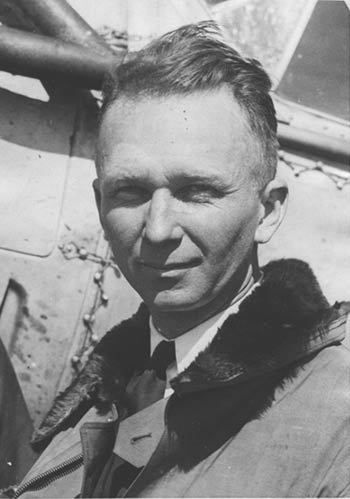 |
Clarence Chamberlin signed the Parks Airport Register on Sunday, February 16, 1930 at 5:45PM. He flew his Crescent Model A he identified as NC9769, a closed cabin airplane powered by a 300HP Wright J-6 engine. As best I can tell, this airplane was S/N 1. Based at Jersey City, NJ, he identified no destination or passengers. In the remarks section he wrote, "Jefferson?" Perhaps this referred to the possibility of his staying at the Jefferson Hotel just west across the Mississippi River in downtown St. Louis, MO. Photograph, right, is courtesy of the San Diego Aerospace Museum (SDAM) Flickr Stream.
Chamberlin was born November 11, 1893 at Dennison, IA. He flew West October 31, 1976 carrying Transport pilot certificate T190. In between he lived a grand life in aviation as a military pilot/trainer, barnstormer, record setter, trans-Atlantic flier and entrepreneur.
Chamberlin first began flying at an aerial sign-towing company. He won his wings in 1918 after enlisting in the Aviation Section of the Signal Corps. After his service in WWI as a 2nd lieutenant (the conflict ended before he traveled to fly in Europe), he barnstormed throughout the eastern part of the United States during the early 1920s. He became a dealer in surplus aircraft, as well as a company pilot for the Wright Corporation.
In 1925, Chamberlin was in a business relationship with the Wright-Bellanca Aircraft Company. Businessman Charles A. Levine, who owned a company called Columbia Salvage, bought the Bellanca operations, as well as the services of Guiseppe Bellanca and Chamberlin. Levine was a fractious personality and his behavior would not serve him well.
When the $25,000 Orteig Prize was offered for the first person to fly across the Atlantic Ocean from New York to Paris, it was several years before Charles Lindbergh, in late 1926, came to Levine to purchase a Bellanca monoplane for the job. It was Levine who placed the stipulation upon the transaction that he would choose the pilot for the flight, and that it probably wouldn't be Lindbergh. Long story short, Lindbergh declined the Bellanca, went instead to the Ryan Company in San Diego, CA (see Register pilot T. Claude Ryan), and bought the "Spirit of St. Louis" (NX211).
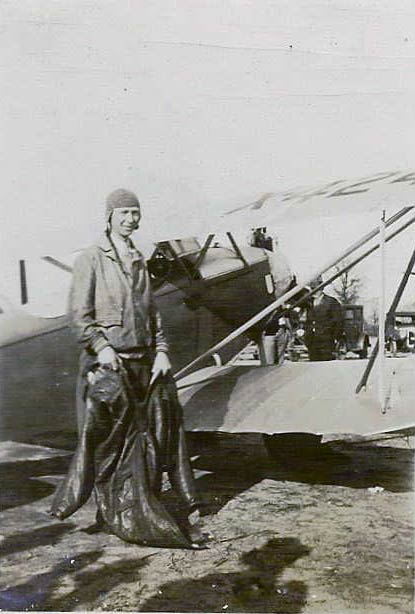 |
Nevertheless, with Lindbergh out of the picture, Chamberlin and Levine endeavored to enter the competition as well. They prepared a Wright-Bellanca WB-2 aircraft owned by Levine, NX237, named "Columbia" (not a Register airplane). To prove the airplane, Chamberlin, careful in his preparations, flew it, with Pitcairn Field Register pilot Bert Acosta, to an endurance record. On April 12, 1927, about a month before Lindbergh's flight, Chamberlin and Acosta took off and flew over Long Island, NY for 51 hours, 11 minutes, and 25 seconds. The estimated distance flown was 4,100 miles, 500 more miles than was needed for the Ortieg Prize attempt between New York and Paris.
Levine meantime was in a legal quarrel over who would fly and navigate his airplane to Europe. Again, long story short, the debate lasted while Lindbergh flew to Paris and won the Orteig prize. Ultimately, Chamberlin was chosen to fly the Bellanca solo.
On June 4th, the "Columbia" and Chamberlin were ready to depart for Europe. At the last minute, Levine jumped in the plane and was flown by Chamberlin to Eisleben, Germany.
Levine's action was premeditated, as he had stowed a flight suit on board, and had his lawyer draft a letter to his wife explaining what he was going to do. The letter was delivered to Mrs. Levine by the attorney after Levine was airborne. Through his trickery, Levine became the first passenger to cross the Atlantic Ocean by air. Curiously, nobody knows about Levine today, and only a few aviation aficionados know much about Clarence Chamberlin.
Photograph, left, from ancestry.com, shows Chamberlin ca. 1928 about a year after his trans-Atlantic flight with "Columbia" and Levine. He appeared to be preparing to don a leather flight suit. The airplane and context were not identified. There is no airplane in any Register database that begins with NC or NX424--.
The "Columbia" would fly the Atlantic again in 1930, this time from Canada to Scotland, becoming the first airplane to cross that ocean twice. It was used for a few other long-distance flights and was ignominiously lost to a hangar blaze in 1934. The only relics remaining from the "Columbia" are an ashtray fashioned from the aluminum metal that comprised one of the fuel tanks and a section of fabric from the fuselage. The National Air & Space Museum (NASM) owns the ashtray, pictured below (item number A19610015000).
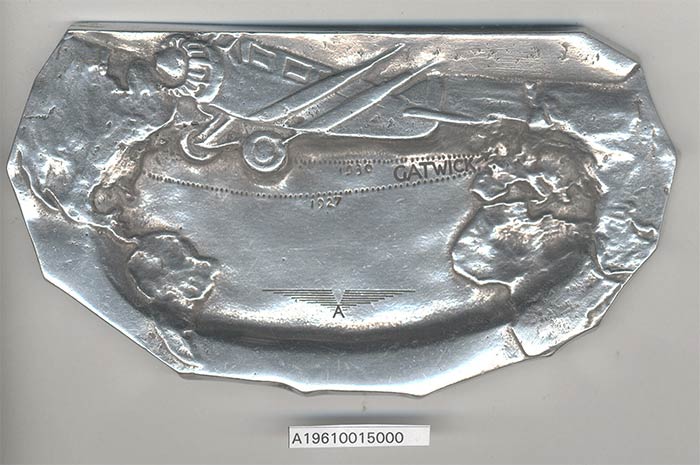 |
The two Atlantic Crossings are illustrated with punch lines. If you look closely, the 1927 route goes into Germancy; the 1930 route ends at Gatwick. The bottom of the ashtray is engraved with its provenance, below. The airplane was renamed "Miss Columbia" for its second crossing.
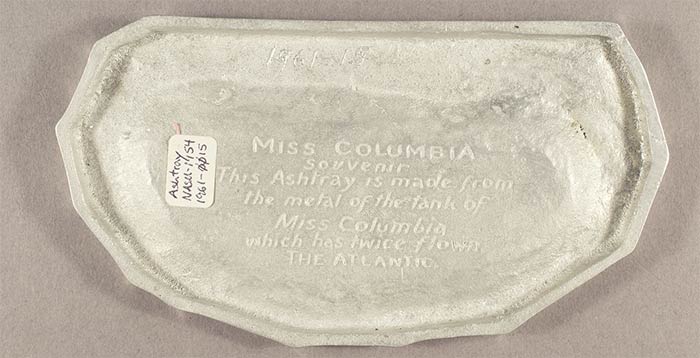 |
The Allen Airways Flying Museum has one side of fuselage fabric from the Columbia as flown from New York to Berlin by Chamberlin with Levine as passenger. Chamberlin's 1927 passport is also in the collection along with one of his log books.
Upon his reputation as trans-Atlantic flyer, Chamberlin began building serial entrepreneurial adventures. He designed his own line of Crescent monoplanes, one of which he flew to Parks Airport (see above). By all indications, NC9769 was also flown by Chamberlin in the 1929 Natonal Air Races (NAR; see below).
Later he acquired a diesel-powered Lockheed Vega, in which he set a world altitude record of 19,393 feet on January 24, 1932 over Floyd Bennett Field. Chamberlin had been working with Register pilot Ruth Nichols on other projects, but she took the same airplane and three weeks later set a new record of 19,928 feet. Importantly, this record is still a big deal, because it has never been broken by any other diesel-powered aircraft and it still stands. It is also the only standing record still claimed by a Lockheed Vega. Both Chamberlin and Nichols were fêted and awarded prizes for their accomplishments at the National Aeronautical Association. Their awards were featured in an article in The New York Times of February 17, 1933.
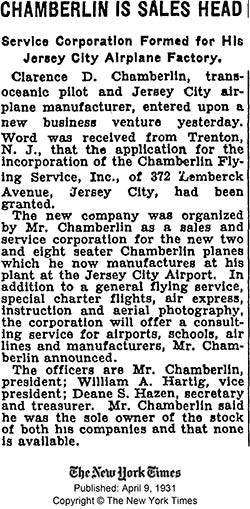 |
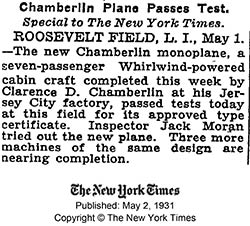 |
The New York Times (NYT) of April 9, 1931, left, reported the formation of the Chamberlin Flying Service in Jersey City, NJ. It appeared that his new company would be the marketing arm for his line of aircraft, as well as a service and consulting company.
Less than a month later, his aircraft design was approved and a type certificate was granted by the federal government. This was reported briefly in The New York Times of May 2, 1931, right.
 |
He next formed Chamberlin Airline between New York and Boston. Popular Aviation (PA) magazine, right, reported in November, 1935 the formation of that line. When his airline seemed doomed for failure, he used its Curtiss Condors for a barnstorming group during the next five years, plus operating his own flight school and aircraft dealerships.
From about 1935 to 1938, Chamberlin operated a flying circus, which flew two of his large, Curtiss Condors and a smaller biplane around the country offering rides to all comers. The two Condors were modified to hold 27 seats, and each seat filled was charged $1-$3 to fly. On some days, Chamberlin and his crew of seven managed to fly 1-2,000 passengers, sometimes more, sometimes less. Although several thousand dollars per day was a lot of money in the 1930s (as it is today), his expenses for fuel, oil, maintenance, salaries and transient housing cut into the gross. Regardless, unlike many other citizens, he had a very productive business going, with reliable income, despite the depths of the Great Depression. He made more money giving inexpensive, short rides than he would have with his airline.
The article below from the November, 1938 issue of PA described the air circus operation.
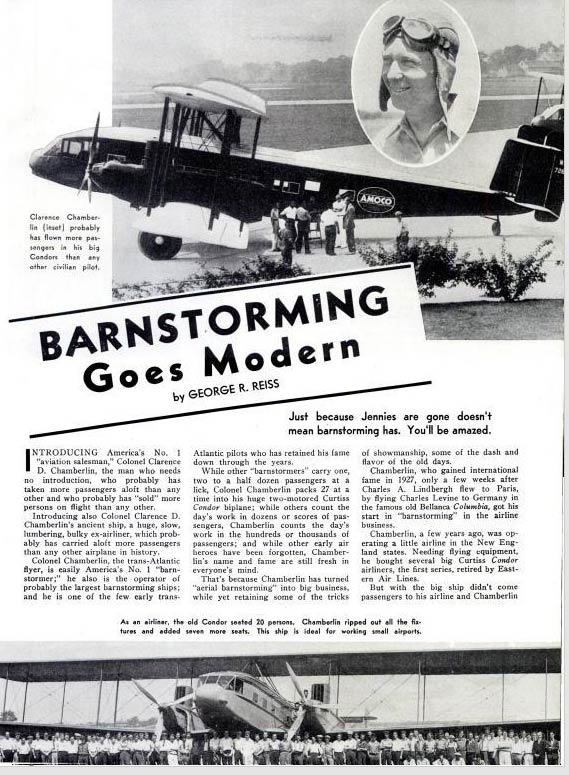 |
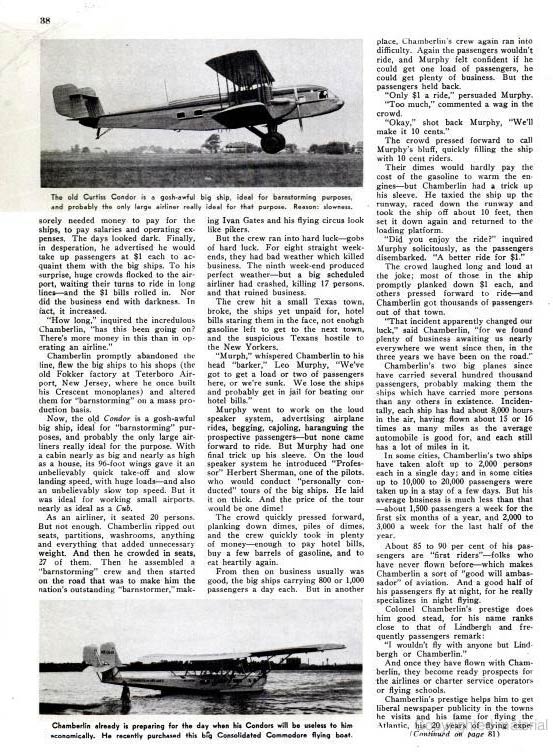 |
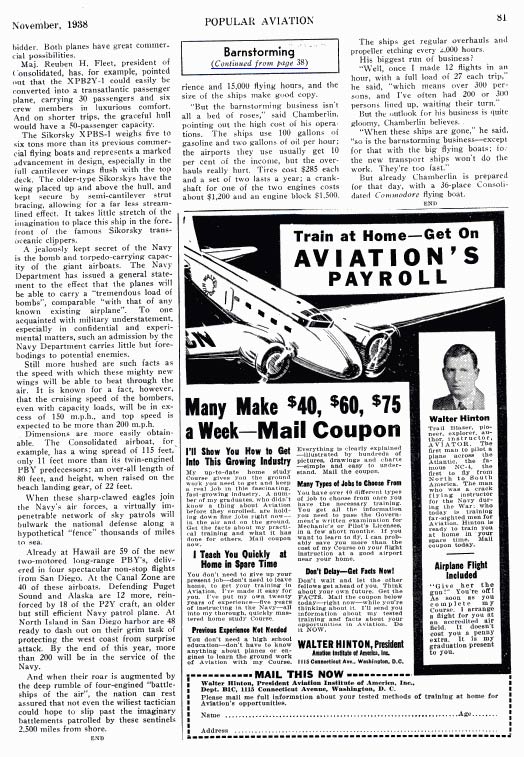 |
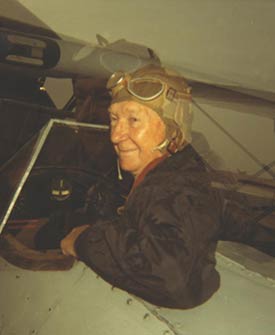 |
Photograph, right, is from the SDAM Flickr stream cited above. In 1930 the Denison, IA airfield was named Chamberlin Field. Chamberlin was honored in the National Aviation Hall of Fame, Dayton, OH, and the State of Iowa Hall of Fame. He was an Early Bird of Aviation. More biographical information is at these links.
Chamberlin placed 6th in the 1929 NAR race for 510 cubic inch or less engines (event no. 9). He also competed in the Cleveland to Buffalo, NY efficiency race (event # 10), but placed 16th, well out of the money.
Chamberlin also landed once, about two years earlier, at Pitcairn Field in Willow Grove, PA. Based at New York, NY, his landing there on March 22, 1928 included no information about his airplane or passengers. Please direct your browser east to Pennsylvania for Chamberlin's biography page on the Pitcairn Field Web site. There you will find numerous photographs, more biographical information and U.S. Census data.
Chamberlin has a good Web presence, including a 2011, feature-length documentary about his life posted on YouTube at the link (1hr. 50min.). The film includes footage of his son, Phillip and daughter, Clarisse, speaking about their father. It exhibits images of his wives, Wilda and Louise. There is moving picture coverage of his reception in Germany in 1927 after his trans-Atlantic record flight.
An article appeared in Skyways magazine (v. 93, April, 2011) describing the documentary. You can download the article at the link (PDF 795kB). The film was posted online during June, 2016. It's worth your time to watch.
---o0o---
SPONSORED LINKS
THIS PAGE UPLOADED: 07/14/16 REVISED:
